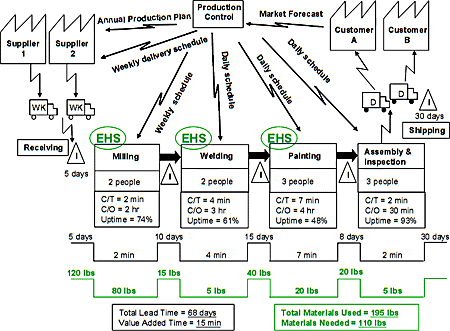Value Stream Mapping
Value stream mapping is a popular manufacturing technique. It analyzes the flow of materials and information necessary to create a product or provide a service. The technique originated at the Toyota Corporation and is referred to as material and information flow mapping. It can be applied to any process that requires improvement. When using value stream mapping, the process being analyzed is illustrated in a step-by-step manner that depicts details such as material receipt through product assembly. It is most typically applied when a company is looking to improve process efficiency in order to remove unnecessary steps or find wasted labor or material.
How is Value Stream Mapping Implemented?
The steps to implement value stream mapping are:
Step 1 – Determine the product or service to be analyzed.
Step 2 – Author a value stream map that depicts the process steps, information flows, and timelines that are required to create the product or service being analyzed. The mapping can either be a design, production, or service flow and may use standardized value mapping process symbols.
Step 3 – Examine the process streams on the value stream map to determine if there are any redundancies or wasteful steps and mark them for modification or deletion.
Step 4 – Redraw the mapping as a future state value stream map with the wasteful steps removed.
Step 5 – Implement process changes in the organization to work towards the new value stream mapping.
Where is Value Stream Mapping Used?
Since the Toyota Corporation originally introduced it, value stream mapping has been widely used throughout industry in Lean environments to identify process improvements. Although most commonly associated with the manufacturing industry, value stream mapping is also used in the healthcare, software development, service, supply chain, logistics, and product development industries. When the technique is used in the Shigeo Shingo form, the process’s value added steps are depicted horizontally across the center of the mapping. Vertical lines that are at right angles to the value stream depict non-value-added steps. The vertical line indicates the steps for creating the product at that particular stage of the overall process, with the overall goal being to create a new mapping that has minimum delay.
Value Stream Mapping Tools
A number of software applications have emerged as alternatives to the traditional pencil and paper method of value stream mapping. These include:
- Product variety funnel
- Quality filter mapping
- Overall structure maps
- Decision point analysis
- Process activity mapping
- Supply chain responsiveness matrix


Comments - No Responses to “Value Stream Mapping”
Sorry but comments are closed at this time.